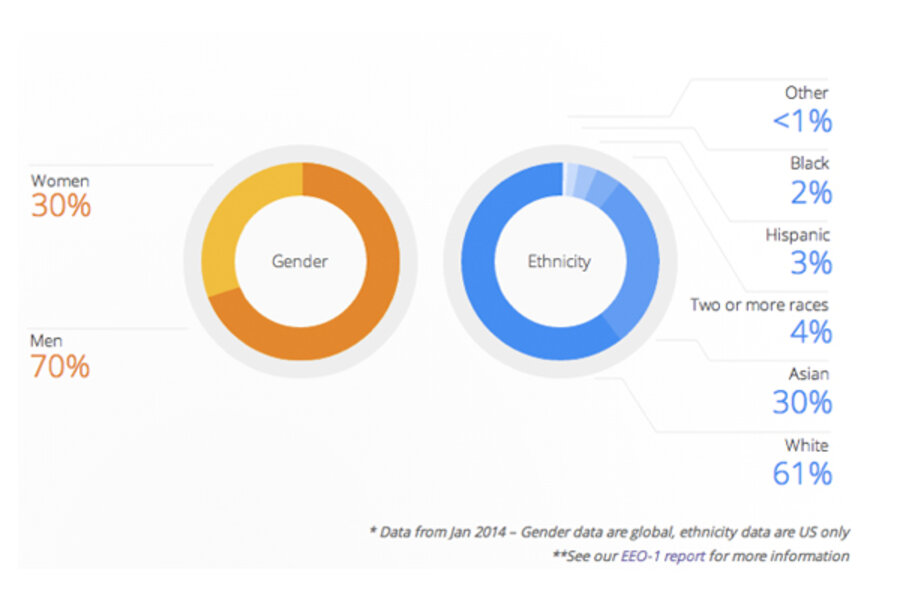Google's diversity problem: 70 percent male, 2 percent black
Loading...
Google’s workforce is overwhelmingly white and male.
Surprised? Google isn’t either.
Google released its diversity data in a blog post Wednesday that revealed 70 percent of the company’s global workforce is male, and its US workforce is less than 2 percent black and 3 percent Hispanic. Though Silicon Valley’s highly concentrated pool of tech companies, start-ups, accelerators, and investors is notoriously white- and male-dominated, this is the first time that a major tech company has publicly addressed the issue. This move comes in response to a growing number of women speaking out against issues of harassment and misogyny in the tech sector, and a push by Jesse Jackson Sr. to draw attention to Google and other tech companies’ glaring lack of diversity.
“We’ve always been reluctant to publish numbers about the diversity of our workforce at Google,” says Laszlo Bock, senior vice president of people operations at Google in a blog post. “We now realize we were wrong, and that it’s time to be candid about the issues. Put simply, Google is not where we want to be when it comes to diversity, and it’s hard to address these kinds of challenges if you’re not prepared to discuss them openly, and with the facts.”
In addition to the stats above, Google revealed that 61 percent of its US workforce is white and 30 percent is Asian. Workers who are black, Hispanic, other, or two or more races combined make up less than 10 percent. Overall in the United States, 12 percent of workers are black and 5 percent are Asian, according to US Bureau of Labor statistics.
Though women make up 30 percent of Google’s worldwide workforce, they only account for 17 percent of its technical teams and only 21 percent of the company's leadership is made up of women. Comparatively, women make up 47 percent of the US workforce and 20 percent of software developers, according to US Bureau of Labor statistics.
Though these numbers reflect disparities in hiring for women and minorities overall in the US, the tech sector has quickly become one of the most lucrative. Fortune ranked Google first in its list of 100 best companies to work in part due to its job growth (20 percent). Glassdoor recently ranked Google as the top US employer based on compensation and benefits: the average software engineer at Google has an average base salary of $128,000. The Bureau of Labor predicts the number of IT jobs overall will grow faster or much faster than average through 2020.
The tech sector has long blamed a faulty pipeline that doesn’t adequately prepare many different kinds of people for jobs in programming, which limits hiring. Mr. Bock echoed this sentiment pointing out “women earn roughly 18 percent of all computer science degrees in the United States. Blacks and Hispanics make up under 10 percent of U.S. college grads and collect fewer than 5 percent of degrees in computer science majors, respectively."
In response, Google itself has invested $40 million in organizations encouraging women to participate in the tech sector, and is working to improve programs at historically black colleges and universities. This also comes after the Rev. Jackson visited the campuses of Google, Hewlett Packard, and Facebook and called on the companies to release their workplace demographics. Google is the only one to release the data so far.
However, recent incidents have indicated the issue may be cultural as well: 56 percent of women who do enter the tech sector leave by midcareer, double the rate for men, according to research from the Harvard Business School. The reason? Many describe a fraternity-like culture that isolates, if not endangers, women. Julie Ann Horvath, a programmer, recently made headlines for accusing her former employer, coding website GitHub, of sexual harassment. A pair of Australian app developers pitched an app at high-profile hackathon TechCrunch Disrupt that takes photos of the user staring at women’s breasts. And those are just recent high-profile incidents. A group of female tech workers wrote a lengthy post on Model View Culture, a prominent tech blog, discussing the challenges they face daily and the need for more men to stand up for women in the workplace.
“Imagine if you were the only person like you on your team and when you left your computer and came back there was very graphic porn on your screen (a specific example that we have experienced),” the post reads. “Knowing that saying you were uncomfortable would alienate you from the rest of your team even more than you already were; knowing that you would no longer get the mentorship from the senior staff that was involved in these disgusting pranks, would you dare to talk about how it made you feel?”
“Our industry is filled with very smart people,” they continue. “We know that you know how to find the answers to questions you have and also how to challenge an opinion or action you disagree with. Take that same passion that you would apply to technical problems, and apply it to social ones.”








